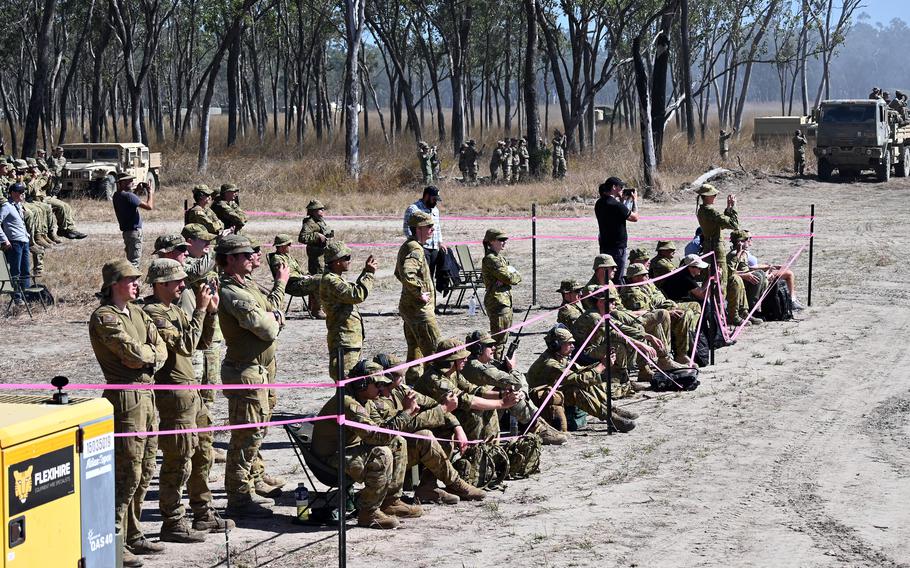
Troops from the United States, Australia and other nations observe a Talisman Sabre firepower demonstration at Shoalwater Bay Training Area in Queensland, Australia, July 14, 2025. (Seth Robson/Stars and Stripes)
BRISBANE, Australia — The U.S. Army fired its mid-range missile system, Typhon, from Australia for the first time this week, striking a maritime target during the ongoing Talisman Sabre exercise, the service announced Wednesday.
The Typhon system, operated by the Hawaii-based 3rd Multi-Domain Task Force, launched an SM-6 missile Tuesday from the Bradshaw Training Area, about 370 miles south of Darwin, according to a news release.
The live-fire drill marked the first time Typhon has been used in the Western Pacific. The system, which includes launchers, missiles and a battery operations center, is capable of firing both SM-6 and Tomahawk missiles.
The task force’s commander, Col. Wade Germann, called the deployment and live-fire “another significant step forward in our ability to deploy, integrate, and command and control advanced land-based maritime strike capabilities,” according to the release.
The missile launch was part of the biennial Talisman Sabre exercise, which began Sunday and runs through Aug. 4. This year’s drills are the largest to date, involving more than 35,000 personnel from 19 countries.
Germann said the operation also validated the task force’s ability to coordinate with the Australian army’s 10th Brigade.
The brigade’s commander, Brig. Gen. Nicholas Wilson, observed a separate live-fire event Monday at Shoalwater Bay Training Area in Queensland, where Australian forces tested the High Mobility Artillery Rocket System, or HIMARS.
A Typhon battery has been stationed in the Philippines since spring 2024, although the Army has not conducted a launch there. The system’s presence has drawn criticism from China, which maintains a large arsenal of intermediate-range missiles and views U.S. deployments in the region as destabilizing.
Beijing’s concerns were echoed in an April 22 report by the Congressional Research Service, which noted that the system’s presence could contribute to deterrence but might also contribute to an arms race.
“Given these reactions, it could be argued that [Typhon] units are contributing to deterrence operations in the Indo-Pacific and might also play a similar role in other regions as well,” the report states.
The U.S. Army is also collaborating with the 10th Brigade in Adelaide, South Australia, to plan the deployment of hypersonic weapons, Lt. Gen. Joel Vowell, deputy commander of U.S. Army Pacific, told Stars and Stripes on Monday at Shoalwater Bay.
“We are looking at how we can do that together,” he said.
Hypersonic weapons travel faster than five times the speed of sound.
In March 2024, the Air Force test-fired the hypersonic AGM-183A Air-launched Rapid Response Weapon from a B-52H Stratofortress bomber over the Ronald Reagan test site on Kwajalein Atoll in the Marshall Islands.
The 1st Multi-Domain Task Force at Joint Base Lewis-McChord, Wash., was the first Army unit to deploy and integrate the new Dark Eagle hypersonic weapon, which has a range of about 1,700 miles.
China has employed an anti-access, area-denial strategy that uses its own missiles to try to control territory around Taiwan and in the South China Sea.
The strategy is focused on ships and aircraft, Vowell said.
“This system changes the game,” he said of hypersonic missiles, while also stressing the importance of “non-kinetic” effects such as cyber operations.